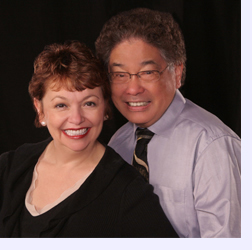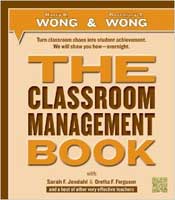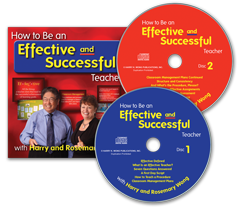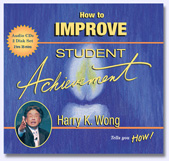
Practical Examples That Work
Through the years, we’ve featured schools that have put into place the practices of effective teachers. You may recall their stories and if not, we’ve given you the link to read their original articles. At the end of this column, we’ll share with you an opportunity to learn from these leaders firsthand.
Achieving AYP
 Karen Whitney, principal, inherited a school with 526 discipline referrals. Four years later that number is down to 54, along with increased attendance. Besides reducing the problems that consumed learning time, she and her teachers focused on a common lesson template and threading literacy throughout their instruction. Their efforts produced the first public school on an Indian reservation to achieve AYP. Karen Whitney, principal, inherited a school with 526 discipline referrals. Four years later that number is down to 54, along with increased attendance. Besides reducing the problems that consumed learning time, she and her teachers focused on a common lesson template and threading literacy throughout their instruction. Their efforts produced the first public school on an Indian reservation to achieve AYP.
Annual Discipline Referrals
|
School Year |
# of Referrals |
Attendance |
08 - 09 |
526 |
92.03% |
09 - 10 |
276 |
91.86% |
10 - 11 |
193 |
94.42% |
11 - 12 |
146 |
94.97% |
12 - 13 |
54 |
95.32% |
Sisseton Middle School in South Dakota continues to thrive. Their success is replicable. How they created a consistent school environment can be found in this past column. The common lesson template and their focus on literacy can be found in this past column.
Reducing Discipline Referrals
 Merlyna Valentine, principal of St. Rose Elementary School, returned to her school after a two-year medical absence to find 574 discipline referrals. Three years later that number dwindled to 89. In 2012, the school received the “Top Gain” School Award by the Louisiana Department of Education for raising the School Performance Score by 8.6 points to 104.6. With more time to focus on learning, the children are achieving in a consistent school environment. Merlyna Valentine, principal of St. Rose Elementary School, returned to her school after a two-year medical absence to find 574 discipline referrals. Three years later that number dwindled to 89. In 2012, the school received the “Top Gain” School Award by the Louisiana Department of Education for raising the School Performance Score by 8.6 points to 104.6. With more time to focus on learning, the children are achieving in a consistent school environment.
Annual Discipline Referrals
|
School Year |
# of Referrals |
08 - 09 |
574 |
09 - 10 |
236 |
10 - 11 |
265 |
11 - 12 |
89 |
Merlyna attributes this success to the schoolwide procedures in place that teach responsibility. To see how they established consistency at the school, read this past column.
Qualifying for a Full Tuition Scholarship
 Carrie Copp is a housemaster—principal of one of the four 1000+ student campuses that make up Brockton High School. Ten years ago, Brockton had some of the worst test scores in the state, where some 75 percent of the students failed state tests and over one-third of the students dropped out. Carrie Copp is a housemaster—principal of one of the four 1000+ student campuses that make up Brockton High School. Ten years ago, Brockton had some of the worst test scores in the state, where some 75 percent of the students failed state tests and over one-third of the students dropped out.
Today, Brockton outperforms 90 percent of the high schools in Massachusetts. The students at Brockton come from underachieving populations and from homes that could be challenging, if not chaotic. For seven hours a day at Brockton, the students find a culture of consistency, predictability, and safety as they go from classroom to classroom.
 Last year, one-third of the graduating class qualified for a four-year, full tuition scholarship to any public university or college in Massachusetts. Last year, one-third of the graduating class qualified for a four-year, full tuition scholarship to any public university or college in Massachusetts.
Starting out as a teacher, Carrie has worn many hats at Brockton High School and has been involved from the beginning in the transformation at the school. As co-chair of the Restructuring Committee, she was directly involved in the planning and implementation of the changes that needed to be made at the school. Read this past column for the details of the transformation at Brockton High School.
Ranking #1 in New York City
 Rose Kerr is principal of PS 861, a K-8 school also known as the Staten Island School of Civic Leadership (SISCL). The school is the brainchild of hers and her assistant principal, Donna Nilsen. Within two years, SISCL earned the distinction as the highest rated school in the New York City Public Schools out of 1,440 schools. This neighborhood school is remarkably simple, yet dramatically productive. Rose Kerr is principal of PS 861, a K-8 school also known as the Staten Island School of Civic Leadership (SISCL). The school is the brainchild of hers and her assistant principal, Donna Nilsen. Within two years, SISCL earned the distinction as the highest rated school in the New York City Public Schools out of 1,440 schools. This neighborhood school is remarkably simple, yet dramatically productive.
 The innovation at this school is how the teachers work together. Rose divided her entire staff into triads, not professional learning communities, not teams, but triads. There is a high level of trust for the professionalism of teachers to determine the curriculum, teach the kids, and solve their own problems. The students have multiple professionals to chart their progress and the teachers have each other for collaboration and support. Read this past column to read about the trust that exists at SISCL. Read this past column to read about the collaboration that exists at SISCL. The innovation at this school is how the teachers work together. Rose divided her entire staff into triads, not professional learning communities, not teams, but triads. There is a high level of trust for the professionalism of teachers to determine the curriculum, teach the kids, and solve their own problems. The students have multiple professionals to chart their progress and the teachers have each other for collaboration and support. Read this past column to read about the trust that exists at SISCL. Read this past column to read about the collaboration that exists at SISCL.
Producing Award-Winning Teachers
 Nic Clement is superintendent of the Flowing Wells Unified School District in Tucson, Arizona. The Flowing Wells Unified School District has the finest professional development program in America. The carefully thought-out professional development program is comprehensive, coherent, and sustained. Every teacher and administrator, even one who has taught for years elsewhere, receives 21 hours of instruction in effective instructional practices. Nic Clement is superintendent of the Flowing Wells Unified School District in Tucson, Arizona. The Flowing Wells Unified School District has the finest professional development program in America. The carefully thought-out professional development program is comprehensive, coherent, and sustained. Every teacher and administrator, even one who has taught for years elsewhere, receives 21 hours of instruction in effective instructional practices.
The Flowing Wells professional development program emphasizes five critical attributes that are the cornerstones of the district’s vision: |
|
- Effective instructional practices
- Effective classroom management procedures and routines
- A sensitivity to and understanding of the Flowing Wells community
- Teaching as a reflection of lifelong learning and ongoing professional growth
- Unity and teamwork among administration, teachers, support staff, and community members
|
As a result, Flowing Wells has produced more teacher-of-the-year nominees and winners than any other district in Arizona. Read this past column to learn more about the success of this school district.
Turning Around a Dysfunctional School |
 Chelonnda Seroyer arrived at Phoenix Academy in Detroit, Michigan, and saw no organization, no structure, no rules, no procedures, no lesson objectives—basically, no culture of consistency that would serve as a pathway to success for the students and the teachers. The students were left each day to flounder and survive in whatever was the prevailing environment. Chelonnda Seroyer arrived at Phoenix Academy in Detroit, Michigan, and saw no organization, no structure, no rules, no procedures, no lesson objectives—basically, no culture of consistency that would serve as a pathway to success for the students and the teachers. The students were left each day to flounder and survive in whatever was the prevailing environment.
What Chelonnda saw from room to room was a gross lack of schoolwide procedures, with everyone operating in a toxic environment of inconsistency, which resulted in confusion and a loss of learning everywhere. The children were hostages of a school that lacked any culture—or consistency. Children and parents hoping to find a sanctuary at the school only found more chaos to support their already chaotic lives.
Read this past column to see how Chelonnda, the assistant principal, and a teacher turned this school around in one year.
Focusing on Effectiveness for Thirty Years
 Our journey through this amazing profession has had one consistent message—the teacher is the most important factor in student achievement. Over 1 million educators have heard this message in speeches. Over 3 million educators have come in contact with our materials and the feedback has been consistent—it works! Our journey through this amazing profession has had one consistent message—the teacher is the most important factor in student achievement. Over 1 million educators have heard this message in speeches. Over 3 million educators have come in contact with our materials and the feedback has been consistent—it works!
What we say is research-based and has influenced hundreds of thousands of educators through the years. The more than 120 columns we have written for Teachers.net reflect many of the practices teachers, schools, and school districts have put into practice. Each column has had its own unique spin on what the teachers, schools, and districts have done to achieve effectiveness. And while the settings and circumstances are all unique, the common thread is—it’s the teacher—and what the teacher does in the classroom to get students to achieve. The more effective the teacher, the better the opportunity for children to learn.
Inviting You to Learn from the Best
We’ve gathered the people we have highlighted in this column to join us at two conferences this June. Last year, some of the same people were with us at the same conference hosted by Louisiana State University. That conference sold out one month in advance. We’re doing the conference again, adding some new speakers and adding one more venue outside of Chicago, Illinois. Unlike many meetings you possibly attend that have no agenda, no focus, this meeting is laser-focused on one thing: How to create an effective school for student achievement.
This IS NOT a conference |
|
- with a mélange, mishmash, and jumble of speakers and workshops to pick from.
- where a government or philanthropic turnaround, curriculum program, initiative or evaluation system will be proposed.
- where money is needed to implement the strategies shared.
- where costly technology will be needed.
- where platitudes, clichés, buzzwords, or admonishments abound.
|
| This IS an implementation conference |
|
- where you will hear each speaker.
- where you will be shown how to create an effective school with effective teachers.
- where everyone is accessible for questions and discussion.
- where the focus is on helping YOU become effective.
- where you will leave with the tools to DO IT and expect results.
|
If anyone needs a blueprint to organize a school for
learning and achievement, the Wongs have it for you.
Wayne Watts, Principal
Stockbridge, Georgia |
| |
Day 1 of the conference is geared to school leaders and anyone who dreams of being one. Day 2 is targeted for the classroom teacher. It’s a day where we and Chelonnda Seroyer will show you how to organize and run your classroom to |
| |
- get your students to do what you want them to do.
- get your students to learn what you want them to learn.
- start class with no wasted time.
- eliminate discipline problems.
- teach procedures so every student knows what to do, how to do it, and when to do it.
- establish consistency so the class responsibly runs itself.
- write meaningful assignments that result in student learning.
- assess for student learning to help students make progress.
|
The bottom line—just do it. It WORKS! |
Attend one or both days. It’s an investment in your professional career. Click here to go to the conference page for the June 10 and 11 meeting in Baton Rouge, Louisiana. Click here to go the conference page for the June 24 and 25 in Matteson, Illinois, outside of Chicago.
We hope to see you and your team at one of these meetings. You will leave energized, refreshed, and empowered to continue on your journey in the noblest of all professions—teaching.
 For a printable version of this article click here. For a printable version of this article click here.
|



 Karen Whitney
Karen Whitney Merlyna Valentine
Merlyna Valentine Carrie Copp
Carrie Copp Last year, one-third of the graduating class qualified for a four-year, full tuition scholarship to any public university or college in Massachusetts.
Last year, one-third of the graduating class qualified for a four-year, full tuition scholarship to any public university or college in Massachusetts. Rose Kerr
Rose Kerr The innovation at this school is how the teachers work together. Rose divided her entire staff into triads, not professional learning communities, not teams, but triads. There is a high level of trust for the professionalism of teachers to determine the curriculum, teach the kids, and solve their own problems. The students have multiple professionals to chart their progress and the teachers have each other for collaboration and support. Read
The innovation at this school is how the teachers work together. Rose divided her entire staff into triads, not professional learning communities, not teams, but triads. There is a high level of trust for the professionalism of teachers to determine the curriculum, teach the kids, and solve their own problems. The students have multiple professionals to chart their progress and the teachers have each other for collaboration and support. Read  Nic Clement
Nic Clement Chelonnda Seroyer
Chelonnda Seroyer Our journey through this amazing profession has had one consistent message—the teacher is the most important factor in student achievement. Over 1 million educators have heard this message in speeches. Over 3 million educators have come in contact with our materials and the feedback has been consistent—it works!
Our journey through this amazing profession has had one consistent message—the teacher is the most important factor in student achievement. Over 1 million educators have heard this message in speeches. Over 3 million educators have come in contact with our materials and the feedback has been consistent—it works!






